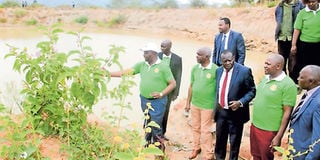Ponds come to the rescue of arid villages

Makueni County Governor, Kivutha Kibwana and Machakos County Deputy Governor, Francis Maliti together with other officials during the launch of the farm pond agribusiness programme in Machakos County. The ponds have the potential to improve food security through capture, storage and provision of irrigation water. PHOTO | LILLIAN MUTAVI | NMG
What you need to know:
- The changing weather pattern has had a serious impact on the country since almost 98 per cent of Kenya’s agriculture is rain-fed.
- The ponds are filled by runoff or tailwater from irrigation, which is then recycled.
- Using farm pond water uses little energy and few resources. Machakos Deputy Governor Francis Maliti says the project will change the food situation in the region.
- Makueni has adopted the 10 by 10 feet hole for every homestead while in Machakos, it is the 10x10 metre rule.
As drought ravages some parts of Kenya, farmers in Machakos have turned to a new irrigation technology.
Raphael Kyaalanio from Wamunyu is among the 11,000 locals who have adapted the farm ponds technology.
“It takes little space on the farm,” he said, adding that locals have been trained on harvesting runoff when it rains.
Every farmer targeted will get a paper lining from the county government.
“We were asked to dig a 10-by-10 metre hole for every acre,” Kyalaanio said.
The changing weather pattern has had a serious impact on the country since almost 98 per cent of Kenya’s agriculture is rain-fed.
The major challenge farmers face is timing. It’s critical for them to know when rains start and stop as it helps in planning on planting and harvesting.
Farm ponds have the potential to improve food security through capture, storage and provision of irrigation water. The lining stops the water from sipping in the ground.
RAINS HAVE BECOME UNRELIABLE
The ponds are filled by runoff or tailwater from irrigation, which is then recycled. They can also be filled by pumping water from streams during the peak season.
Using farm pond water uses little energy and few resources. Machakos Deputy Governor Francis Maliti says the project will change the food situation in the region.
He adds that what the farmers learnt during their tour of Makueni County would have a huge impact in Machakos.
During the same forum on October 9, Makueni Governor Kivutha Kibwana said his administration came up with the farming model because rains have become unreliable.
Makueni has adopted the 10 by 10 feet hole for every homestead while in Machakos, it is the 10x10 metre rule.
Afterwards, farmers will use drip irrigation to grow their crops. To lead the way, African Brotherhood Church Archbishop Timothy Ndambuki has started a farm pond project. He hopes it will be adapted by the South Eastern Kenya Economic Block.
Apart from the linings, farmers will get seedlings from the county government and the Kenya Cereal Enhancement Programme (K-CeP), a national government scheme. Farmers in Mwala, Yatta, and Masinga will get equipment and inputs.





